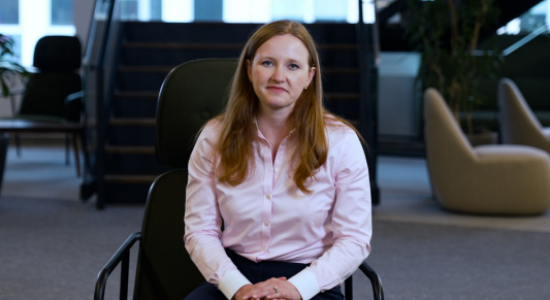 Many people know agile in the context of digital organizations and technology. What many people don't realize is that agile best practices can be brought to any function, within any organization, to drive innovation and continuous improvementEmily Padon, Engagement Manager
Many people know agile in the context of digital organizations and technology. What many people don't realize is that agile best practices can be brought to any function, within any organization, to drive innovation and continuous improvementEmily Padon, Engagement Manager
- About this video
- Transcript
Companies across the energy industry face pressure to transform but struggle to engrain innovation within the business. Discover how to drive agile operations.
Oliver Wyman Takes On Series
In this video series, energy and natural resources experts share their take on how businesses can harness risk, turn climate intent into action, and lead in the age of acceleration.
Many people know "agile" in the context of digital organizations and technology. What many people don't realize is that agile best practices can be brought to any function, within any organization, to drive innovation and continuous improvement.
I am Emily Padon and I work with our clients to design innovation roadmaps and execute against them, and teach them how they can bring innovative capabilities in-house in the form of innovation hubs.
Part of what I love about what I do is that I'm really helping to transform organizations who have never had the opportunity to think and execute in such creative ways. I studied actuarial science and mathematical finance, and actuarial science is about calculating risk and probability. And in innovation, it's all about taking calculated risks with the possibility of massive returns.
Innovation is important for companies as studies have shown that companies who innovate will grow their bottom line at a rate that's 22% higher than companies who don't.
The last few years have just made it more apparent in how vital innovation is to a company's success. Consider the global pandemic and supply chain shortages and a changing labor market. Companies have been forced to innovate and are seeing the benefits of innovation. Now they're wondering ‘how do we make innovation more central to our organizations and more core to what we do?’
At its core, the agile approach is about incrementality, collaboration, and moving fast. Some of the most common mistakes I see when clients are trying to adopt the agile approach are, firstly, not picking a goal that is targeted enough and that can be completed in a short amount of time. A company who sets out to automate 80% of their backend processes within a quarter will be much more likely to achieve the stated goal than a company that sets out to digitize their operation.
Second, not taking time to understand who will be impacted by the innovation and preparing for that change management. For example, I worked with a large waste collections player who was trying to improve navigation in their trucks with a new GPS system. After launching the GPS system, they realized that the roar of the truck in the cab actually made it impossible to hear the GPS directions. They ended up having to spend 30% more than they had originally budgeted just to put speakers in every truck to actually let the drivers hear the system.
In this situation, we helped the client understand that had they taken a more incremental approach and gotten user feedback much earlier with a prototype in a truck, they would have come in, if not at cost, at least on time with the project.
And lastly, thinking that technology is the only answer to innovation and ignoring potentially high impact people or process solutions that can be leveraged instead.
Technology, while wonderful, can oftentimes complicate existing process issues. So it's so important to consider both process and technology when bringing in any new innovation.
I want to leave you with advice that I frequently offer organizations who are looking to adopt an agile approach.
First, the key is to start small. One team, one outcome, one quarter.
Second, know what you're trying to achieve and how you're going to measure progress against it.
Third, be ready to abandon the idea if you don't see the desired results in a quarter.
Keep in mind that the agile mindset is as much about failing fast as it is about delivering quickly. You can improve your chances of winning by putting upfront due diligence into the business case.
I'm encouraged by how many companies I already see adopting innovation hubs within their own organizations, and I'm looking forward to more growth in this space.
I'm always excited by opportunities to help our clients chart their paths toward nimble and agile operations.
I'm Emily Padon and this has been my take on agile operations.
This transcript has been edited for clarity
- About this video
- Transcript
Companies across the energy industry face pressure to transform but struggle to engrain innovation within the business. Discover how to drive agile operations.
Oliver Wyman Takes On Series
In this video series, energy and natural resources experts share their take on how businesses can harness risk, turn climate intent into action, and lead in the age of acceleration.
Many people know "agile" in the context of digital organizations and technology. What many people don't realize is that agile best practices can be brought to any function, within any organization, to drive innovation and continuous improvement.
I am Emily Padon and I work with our clients to design innovation roadmaps and execute against them, and teach them how they can bring innovative capabilities in-house in the form of innovation hubs.
Part of what I love about what I do is that I'm really helping to transform organizations who have never had the opportunity to think and execute in such creative ways. I studied actuarial science and mathematical finance, and actuarial science is about calculating risk and probability. And in innovation, it's all about taking calculated risks with the possibility of massive returns.
Innovation is important for companies as studies have shown that companies who innovate will grow their bottom line at a rate that's 22% higher than companies who don't.
The last few years have just made it more apparent in how vital innovation is to a company's success. Consider the global pandemic and supply chain shortages and a changing labor market. Companies have been forced to innovate and are seeing the benefits of innovation. Now they're wondering ‘how do we make innovation more central to our organizations and more core to what we do?’
At its core, the agile approach is about incrementality, collaboration, and moving fast. Some of the most common mistakes I see when clients are trying to adopt the agile approach are, firstly, not picking a goal that is targeted enough and that can be completed in a short amount of time. A company who sets out to automate 80% of their backend processes within a quarter will be much more likely to achieve the stated goal than a company that sets out to digitize their operation.
Second, not taking time to understand who will be impacted by the innovation and preparing for that change management. For example, I worked with a large waste collections player who was trying to improve navigation in their trucks with a new GPS system. After launching the GPS system, they realized that the roar of the truck in the cab actually made it impossible to hear the GPS directions. They ended up having to spend 30% more than they had originally budgeted just to put speakers in every truck to actually let the drivers hear the system.
In this situation, we helped the client understand that had they taken a more incremental approach and gotten user feedback much earlier with a prototype in a truck, they would have come in, if not at cost, at least on time with the project.
And lastly, thinking that technology is the only answer to innovation and ignoring potentially high impact people or process solutions that can be leveraged instead.
Technology, while wonderful, can oftentimes complicate existing process issues. So it's so important to consider both process and technology when bringing in any new innovation.
I want to leave you with advice that I frequently offer organizations who are looking to adopt an agile approach.
First, the key is to start small. One team, one outcome, one quarter.
Second, know what you're trying to achieve and how you're going to measure progress against it.
Third, be ready to abandon the idea if you don't see the desired results in a quarter.
Keep in mind that the agile mindset is as much about failing fast as it is about delivering quickly. You can improve your chances of winning by putting upfront due diligence into the business case.
I'm encouraged by how many companies I already see adopting innovation hubs within their own organizations, and I'm looking forward to more growth in this space.
I'm always excited by opportunities to help our clients chart their paths toward nimble and agile operations.
I'm Emily Padon and this has been my take on agile operations.
This transcript has been edited for clarity
Companies across the energy industry face pressure to transform but struggle to engrain innovation within the business. Discover how to drive agile operations.
Oliver Wyman Takes On Series
In this video series, energy and natural resources experts share their take on how businesses can harness risk, turn climate intent into action, and lead in the age of acceleration.
Many people know "agile" in the context of digital organizations and technology. What many people don't realize is that agile best practices can be brought to any function, within any organization, to drive innovation and continuous improvement.
I am Emily Padon and I work with our clients to design innovation roadmaps and execute against them, and teach them how they can bring innovative capabilities in-house in the form of innovation hubs.
Part of what I love about what I do is that I'm really helping to transform organizations who have never had the opportunity to think and execute in such creative ways. I studied actuarial science and mathematical finance, and actuarial science is about calculating risk and probability. And in innovation, it's all about taking calculated risks with the possibility of massive returns.
Innovation is important for companies as studies have shown that companies who innovate will grow their bottom line at a rate that's 22% higher than companies who don't.
The last few years have just made it more apparent in how vital innovation is to a company's success. Consider the global pandemic and supply chain shortages and a changing labor market. Companies have been forced to innovate and are seeing the benefits of innovation. Now they're wondering ‘how do we make innovation more central to our organizations and more core to what we do?’
At its core, the agile approach is about incrementality, collaboration, and moving fast. Some of the most common mistakes I see when clients are trying to adopt the agile approach are, firstly, not picking a goal that is targeted enough and that can be completed in a short amount of time. A company who sets out to automate 80% of their backend processes within a quarter will be much more likely to achieve the stated goal than a company that sets out to digitize their operation.
Second, not taking time to understand who will be impacted by the innovation and preparing for that change management. For example, I worked with a large waste collections player who was trying to improve navigation in their trucks with a new GPS system. After launching the GPS system, they realized that the roar of the truck in the cab actually made it impossible to hear the GPS directions. They ended up having to spend 30% more than they had originally budgeted just to put speakers in every truck to actually let the drivers hear the system.
In this situation, we helped the client understand that had they taken a more incremental approach and gotten user feedback much earlier with a prototype in a truck, they would have come in, if not at cost, at least on time with the project.
And lastly, thinking that technology is the only answer to innovation and ignoring potentially high impact people or process solutions that can be leveraged instead.
Technology, while wonderful, can oftentimes complicate existing process issues. So it's so important to consider both process and technology when bringing in any new innovation.
I want to leave you with advice that I frequently offer organizations who are looking to adopt an agile approach.
First, the key is to start small. One team, one outcome, one quarter.
Second, know what you're trying to achieve and how you're going to measure progress against it.
Third, be ready to abandon the idea if you don't see the desired results in a quarter.
Keep in mind that the agile mindset is as much about failing fast as it is about delivering quickly. You can improve your chances of winning by putting upfront due diligence into the business case.
I'm encouraged by how many companies I already see adopting innovation hubs within their own organizations, and I'm looking forward to more growth in this space.
I'm always excited by opportunities to help our clients chart their paths toward nimble and agile operations.
I'm Emily Padon and this has been my take on agile operations.
This transcript has been edited for clarity


